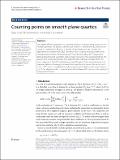Counting points on smooth plane quartics
Author(s)
Costa, Edgar; Harvey, David; Sutherland, Andrew V.
Download40993_2022_Article_397.pdf (704.6Kb)
Publisher with Creative Commons License
Publisher with Creative Commons License
Creative Commons Attribution
Terms of use
Metadata
Show full item recordAbstract
Abstract
We present efficient algorithms for counting points on a smooth plane quartic curve X modulo a prime p. We address both the case where X is defined over
$${\mathbb {F}}_p$$
F
p
and the case where X is defined over
$${\mathbb {Q}}$$
Q
and p is a prime of good reduction. We consider two approaches for computing
$$\#X({\mathbb {F}}_p)$$
#
X
(
F
p
)
, one which runs in
$$O(p\log p\log \log p)$$
O
(
p
log
p
log
log
p
)
time using
$$O(\log p)$$
O
(
log
p
)
space and one which runs in
$$O(p^{1/2}\log ^2p)$$
O
(
p
1
/
2
log
2
p
)
time using
$$O(p^{1/2}\log p)$$
O
(
p
1
/
2
log
p
)
space. Both approaches yield algorithms that are faster in practice than existing methods. We also present average polynomial-time algorithms for
$$X/{\mathbb {Q}}$$
X
/
Q
that compute
$$\#X({\mathbb {F}}_p)$$
#
X
(
F
p
)
for good primes
$$p\leqslant N$$
p
⩽
N
in
$$O(N\log ^3 N)$$
O
(
N
log
3
N
)
time using O(N) space. These are the first practical implementations of average polynomial-time algorithms for curves that are not cyclic covers of
$${\mathbb {P}}^1$$
P
1
, which in combination with previous results addresses all curves of genus
$$g\leqslant 3$$
g
⩽
3
. Our algorithms also compute Cartier–Manin/Hasse–Witt matrices that may be of independent interest.
Date issued
2022-11-21Department
Massachusetts Institute of Technology. Department of MathematicsPublisher
Springer International Publishing
Citation
Research in Number Theory. 2022 Nov 21;9(1):1
Version: Final published version